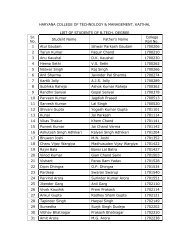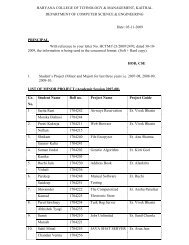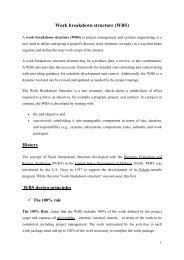Create successful ePaper yourself
Turn your PDF publications into a flip-book with our unique Google optimized e-Paper software.
LECTURE NOTES OF ADVANCED DATA STRUCTURE (MT-CSE 110)<br />
HASHING<br />
Hashing is the transformation of a string of characters into a usually shorter<br />
fixed‐length value or key that represents the original string. Hashing is used to<br />
index and retrieve items in a database because it is faster to find the item <strong>using</strong><br />
the shorter hashed key than to find it <strong>using</strong> the original value. It is also used in<br />
many encryption algorithms.<br />
As a simple example of the <strong>using</strong> of hashing in databases, a group of people<br />
could be arranged in a database like this:<br />
Abernathy, Sara Epperdingle, Roscoe Moore, Wilfred Smith, David (and many<br />
more sorted into alphabetical order)<br />
Each of these names would be the key in the database for that person's data. A<br />
database search mechanism would first have to start looking character‐by‐<br />
character across the name for matches until it found the match (or ruled the<br />
other entries out). But if each of the names were hashed, it might be possible<br />
(depending on the number of names in the database) to generate a unique four‐<br />
digit key for each name. For example:<br />
7864 Abernathy, Sara 9802 Epperdingle, Roscoe 1990 Moore, Wilfred 8822<br />
Smith, David (and so forth)<br />
A search for any name would first consist of computing the hash value (<strong>using</strong><br />
the same hash function used to store the item) and then comparing for a match<br />
<strong>using</strong> that value. It would, in general, be much faster to find a match across four<br />
digits, each having only 10 possibilities, than across an unpredictable value<br />
length where each character had 26 possibilities.<br />
The principle of hashing involves taking a key value from some large range of<br />
values and transforming or mapping it to a smaller range of values. The action<br />
of mapping a key is called hashing and uses a hash function. The resultant<br />
hashed key is used to place a record in an array or hash table. The idea is that<br />
the hash table is much smaller than the array that would have been needed to<br />
hold all possible values, but that it is large enough to hold the expected number<br />
of values in the list.<br />
Prepared By :<br />
Er. Harvinder Singh<br />
Assist Prof., CSE, H.C.T.M (Kaithal) Page ‐ 23 ‐







